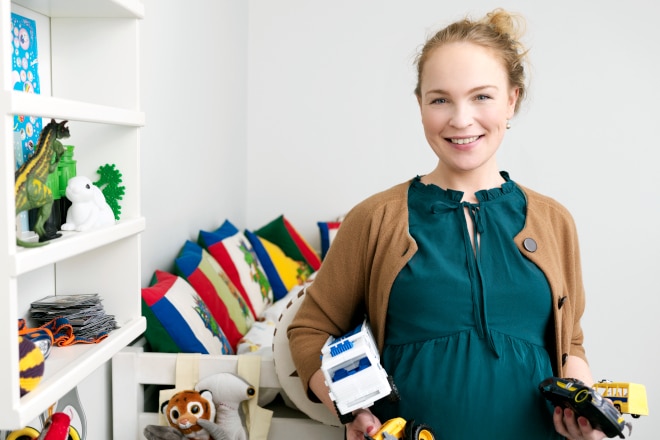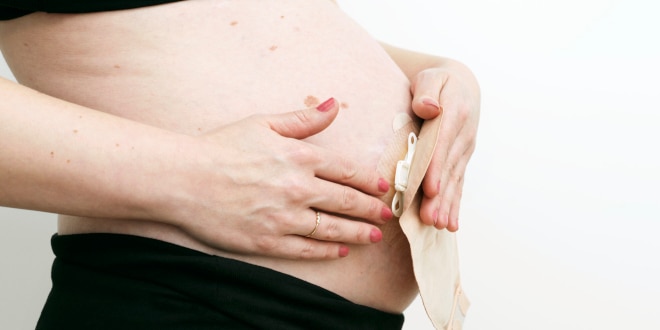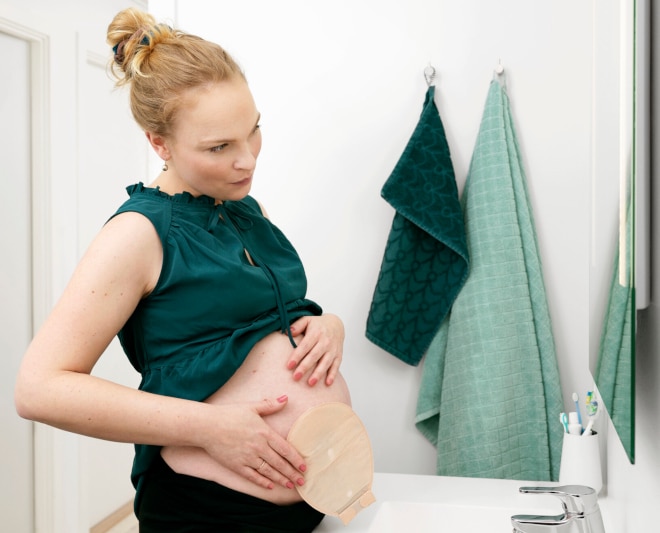Every single pregnancy and every single body are different – but here’s what Kirsten has found important during her two pregnancies. Of course, you should always do your own research when deciding what works best for you.
Braxton Hicks contractions
”In my second pregnancy, I have experienced a lot of strong braxton hicks contractions. I’ve been told that this is not unusual when pregnant with an ostomy, as the colon is located right next to the uterus, to which it can cause some irritation resulting in strong braxton hicks. It’s not dangerous, but it can be a bit unsettling and cause some discomfort. Whenever it happens to me, I have found that it helps to lie down and take a rest to give your body a break.”
People want to touch your stomach – what do you do?
”A baby bump is beautiful – and to some people that triggers a spontaneous desire to touch it. I’ve experienced this several times during my pregnancy and honestly, it can be quite exhausting. Once, I experienced that someone put their hand on my big, round belly to feel the baby – but all they touched was my ostomy bag. That was a very awkward moment and to make sure it never happened again, I learned that if I placed my own hand over the ostomy bag, it forced people to touch my belly somewhere else.”
Make sure to rest
”There’s a lot of pressure on the ostomy during pregnancy. Your uterus is growing, and your baby might kick against your ostomy, which can cause discomfort or perhaps even pain. A good piece of advice is to take daily rests on your back or on your side - supported by pillows - so you can relax. When you lie down in a horizontal position, the pressure against the ostomy is reduced and therefore, it can work both as ‘quick fix’ or as a preventive measure, when taking set rests during the day.”
Look forward to what’s ahead
“It’s natural to have concerns and worries when you’re pregnant – and with an ostomy, it’s common to have even more: What will my pregnancy be like? Will it affect the growth of the baby? Will it be uncomfortable? Will I be more prone to complications? Try to remind yourself, that being worried during pregnancy is completely normal – ostomy or not - but that it’s important to also be happy, excited and believe that everything will be alright. Fear and worry should never overshadow the joy of being pregnant and entering into motherhood.”
Already have kids?
”If you already have kids, I can recommend making a ‘what-if’ plan. In case you suddenly experience complications, it’s nice to know that there’s a plan in place for the rest of the family. When I had to be admitted to the hospital due to complication with my ostomy, it was a great relief to know that my parents were on standby and thus able to take my older son for the week, while I was recovering in the hospital.”

Food & diet
“Changes to the size of the uterus and the pressure from the baby against the colon and ostomy can cause your ostomy to block or slow down the passage of stools. It’s a good idea to be aware of this. Sometimes, you can adjust your food intake yourself – but other times, you’ll need your doctors help to get things going again. Personally, I have experienced several challenges with the passage of stools and intestinal volvulus in this pregnancy, which also caused 1 week of hospitalisation. I therefore had to change my diet to include fewer fibers and gentler foods in general.”
The skin on your stomach
”As a natural part of pregnancy, the skin on your stomach expands to accommodate your growing belly. It’s a well-known beauty tip to rub your belly with different oils and creams into your belly - but this is not a good idea if you have an ostomy, as your ostomy appliance simply can’t keep a tight fit, if placed on an oily belly. At the same time, it’s important to be mindful about your skin. Does it become more sensitive or thin during your pregnancy? I’ve experienced both right underneath the baseplate, where I can see small blood vessels and veins much more clearly than before. To avoid placing more strain on that part of my skin during my changing routine, I’ve consulted my ostomy nurse several times. This has resulted in small adjustments and good advice about my changing routine, as my belly grew in size and shape. For some women, it can also be beneficial to look into other products, as some might be more suited for sensitive skin.”

Take photos of your beautiful belly
“Your belly is beautiful at every stage of the pregnancy. Despite your ostomy and potential scars from previous surgeries, it’s important to remember that your belly is just as beautiful as any other. When I think back on my first pregnancy, I remember feeling abnormal. My belly didn’t look like all the perfect, round bellies that I saw in the pregnancy books I was reading, and it was actually difficult to find information that I could relate to. Therefore, I took almost no photos of my belly, which I later regretted. It’s such a joy to look back at the photos of the growing belly, how it changes, and how the ostomy relocates during the pregnancy.”
Pack your ostomy appliance well in advice before birth
”As a mom-to-be with an ostomy, you not only need to prepare your hospital bag with everything you need for the newborn – you also need to bring a well-equipped bag for your ostomy appliance with everything you might need. I recommend packing your ostomy appliance well in advance, so it doesn’t become a stressful last-minute thing. If you cut your baseplate yourself, it’s my experience that you need to cut a bigger whole at the end of your pregnancy. I recommend pre-cutting 5 different baseplates, so you have different options.”
Prepare for your birth
”Preparing for birth can take many different forms. When you have an ostomy, it can be a good idea to spend some time on preparing your partner and healthcare personnel for everything they need to know about your ostomy and appliance: what products do you use? How much of each? What does your routine look like? The more they know, the more they will be able to assist you during birth and that will create extra peace of mind for you. Don’t be afraid to ask for help!”
Plan for after your birth
”When you speak to your midwife or obstetrician about your upcoming birth, it’s a good idea to plan a visit from an ostomy nurse on the day after you’ve given birth or at least before you leave the hospital. A lot can happen to your belly after giving birth, so make sure you receive professional information and guidance, to avoid potential skin issues, challenges with your appliance etc. Be aware that it’s not something that is automatically planned for you – I have asked for it in both of my pregnancies and the healthcare personnel have always found it to be a great idea.”
Make sure you have full supplies for the time following your birth
“It’s a good idea to ensure full supplies of all your ostomy appliance before you give birth. I recommend ordering an extra batch of products, so you don’t need to worry about that after birth – there will be other things that occupy you.”

At home with your newborn
Must-have in your diaper bag
“Make sure you always have an emergency-kit for changing your ostomy in your diaper bag. As soon as your baby has arrived, you’ll experience that leaving home without the diaper bag is impossible, as it contains all the essentials you need for your baby on-the-go. I felt safer having everything in one bag that I knew I would never leave without.”
Sleep with your baby
”You are a super-mom – also with an ostomy. But make sure you get your sleep. I recommend taking naps when your baby does, rather than spending time on changing your ostomy. My best advice is to prepare everything you need for changing your ostomy and then change your appliance after your nap – at this time you have more energy and patience to do it thoroughly.”

New routines
”In the first days and weeks with a newborn, feeding, rocking, navigating sleeping, and diaper changes occupy much of the day. It may take a while to find a rhythm, but eventually you will notice a pattern in your baby’s needs and settle into a bit of a routine based on your newborn’s schedule. Routines will follow your newborn’s needs – and that also applies for your ostomy changing routine. To make sure you get peace and quiet you need to carry out your routine, I recommend finding a place where your baby feels safe such as your baby’s changing station or in a baby-nest next to you on the bathroom floor. Remember to prepare everything in advance.”
Breastfeeding
”I’ve experienced days where my stomach, colons or ostomy has been too sore to sit upright and breastfeed my baby. To overcome this, the best solution for me was to breastfeed laying down. There are various breastfeeding positions available and you need to try a few before finding a favourite that works best for you and your baby – however, remember that breastfeeding should not be associated with discomfort for either you or your little one.”
